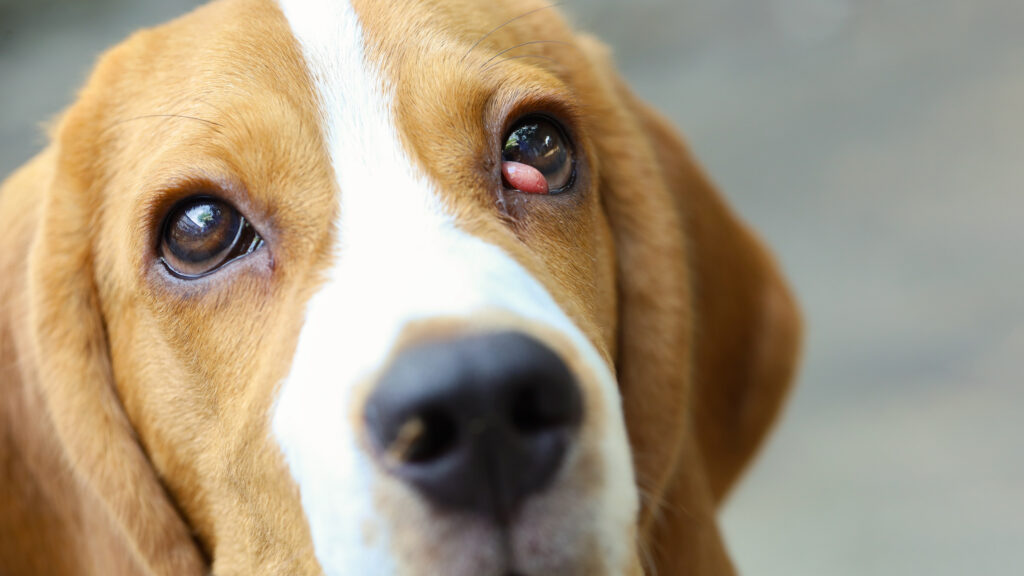Key Points
- If your pup has a red bump peeking out from one or both of their lower eyelids, they probably have cherry eye.
- Cherry eye in dogs is more common in brachycephalic breeds, and it may affect English Bulldogs, French Bulldogs, Pugs, Cocker Spaniels, Beagles, and Boston Terriers.
- Cherry eye isn’t preventable, but it can be corrected with a simple surgery.
As a loving pet parent, you tend to notice every little detail about your furry friend. From their happy butt wiggles when you return home to melting your heart with a single look, you look forward to seeing their familiar face and habits.
So, if you notice an out-of-the-ordinary red bump in the corner of your dog’s eye, it may cause some concern. Commonly known as cherry eye, this bump is likely the result of a prolapsed gland. While it’s not a dangerous condition, it can damage your pup’s tear duct and cause chronic dry eye if left untreated, making your pup extremely uncomfortable.
The good news is that cherry eye in dogs is treatable. Here, we’ve outlined the symptoms and causes of cherry eye in dogs and shared tips for managing this common condition.
What is cherry eye?
Unlike humans, dogs have three eyelids for each eye. Known as the nictitating membrane, the third eyelid is hidden in the corner of the eye inside the lower eyelid. The nictitating membrane provides an added layer of protection and also contains a tear gland kept in place by ligaments. When these ligaments stretch or detach entirely from the orbital bone, the gland can pop out of place (known as a prolapse) and become visible above the eyelid. This creates the appearance of a red, cherry-like growth in the corner of your dog’s eye. Thus, cherry eye is the most common term for this prolapse of the third eyelid gland. One or both eyes can be affected, and you may first notice this bump when your dog is still a puppy.
Veterinarians don’t fully understand what causes cherry eye in dogs — but it typically results from stretched or torn ligaments around the inner eye. This strain can be caused by physical trauma, or it may occur if the affected dog breed is prone to this condition. If their ligaments are weaker, it’s easier for the membrane to pop out from under the third eyelid.
Is cherry eye common in dogs?
Yes, cherry eye is a common occurrence, especially in puppies of certain breeds. Although cherry eye is most commonly found in young dogs during their first year of life, prolapse can still happen to dogs of all ages.
Prolapse of the tear gland is more common in brachycephalic dog breeds, because their squished facial anatomy and shallow eye sockets cause their eyes to protrude from the skull. In some breeds, it’s thought that the fibrous attachment in their eyes is weaker than other breeds, which allows the gland to prolapse easily. In fact, flat-faced breeds are up to 34 times more likely to develop cherry eye, along with other breeds with genetic predispositions. The condition also affects dogs with shorter muzzles, toy breeds, and teacup dogs more than bigger dogs with longer noses.
Generally, the dog breeds most susceptible to developing cherry eye include:
- English Bulldogs
- Cocker Spaniels
- Cane Corsos
- Basset Hounds
- Beagles
- Boxers
- Boston Terriers
- French Bulldogs
- Rottweilers
- Pugs
- Mastiffs
- Shar-Peis
- Lhasa Apsos
What are the signs and symptoms of cherry eye in dogs?
Since cherry eye appears directly on the corner of a dog’s eye, it’s easy for pet parents to detect this condition early on. In most cases, you’ll know it when you see it. The growth is commonly found in the inner corner of the eye and is similar in size and shape to a cherry pit. It will appear as a red swollen mass on the lower eyelid; however, it could also be small and appear periodically. In extreme cases, it may be large enough to cover a significant portion of the cornea, potentially blocking a dog’s vision.
Thick discharge is another sign of cherry eye in some dogs. To curb the discomfort in their eye, your dog may attempt to paw or scratch it, causing more irritation to the already sensitive lower eyelid. They may accidentally scratch the cornea or other parts of the eye, causing further damage or infection. Dogs with cherry eye may also blink or squint excessively — and if there’s a reduction in tear production, they may experience keratoconjunctivitis sicca (chronic dry eye), which can cause even more discomfort. If you notice your dog pawing at their eyes or rubbing their face on the floor, you should take them to the veterinarian.
Cherry eye can come or go, but the prolapse is often permanent. Over time, this condition can make your dog prone to infections and cause severe dry eye irritation. Fortunately, early-stage cherry eye in dogs isn’t painful for most pups, and your dog probably doesn’t even know something is wrong. Nonetheless, any sign of cherry eye or unusual symptoms should be taken seriously and immediately brought to your veterinarian’s attention.
How is cherry eye in dogs diagnosed and treated?

If you think your pup may have cherry eye, talk to your veterinarian as a first step. Left untreated, cherry eye can lead to health concerns over time. For a proper diagnosis, your vet will perform an eye examination to check for a prolapsed gland. They may even run a series of diagnostic tests to better understand your pet’s eye health.
The severity of cherry eye in dogs varies. If caught early, some mild cases only require a warm compress and topical anti-inflammatories, while others may require surgery to replace the third eyelid. At your first visit, your vet may prescribe dog-safe eye drops to reduce inflammation in their eye. Although they can provide much-needed moisture and comfort, eye drops are not a cure for cherry eye. Surgery is the only option to fully relieve your pup’s cherry eye. Non-surgical treatment options can temporarily ease your pup’s discomfort, but it won’t prevent another prolapse from forming on their lower eyelid.
A veterinary ophthalmologist will perform the surgery to replace your pup’s cherry eye, which usually involves stitching the prolapsed gland back down below the lower eyelid. On the off chance that your pup experiences a re-prolapse down the line, your vet may recommend removing the affected gland entirely. Surgery is only an option if the tear gland is actively prolapsed; if your pup’s cherry eye comes and goes rather than remaining a constant in their lower eyelid, your vet may wait until the condition becomes permanent before performing surgery. Likewise, if your puppy is still very young, your vet may recommend waiting for surgery until they’re a little older.
Get your pup the best possible care
When an unexpected illness like cherry eye happens, getting your pup the best care possible is a top priority. However, vet bills can add up fast. If your dog gets sick or hurt, a Pumpkin Dog Insurance plan can help you afford the treatment they need by paying you back for a portion of eligible vet bills.
- https://vcahospitals.com/know-your-pet/conjunctivitis-in-dogs
- https://www.dailymail.co.uk/sciencetech/article-10443687/Dog-breeds-affected-cherry-eye-including-English-bulldogs-American-cocker-spaniels.html
- https://www.ncbi.nlm.nih.gov/pmc/articles/PMC6067592/
- https://www.akc.org/expert-advice/health/cherry-eye-in-dogs/




